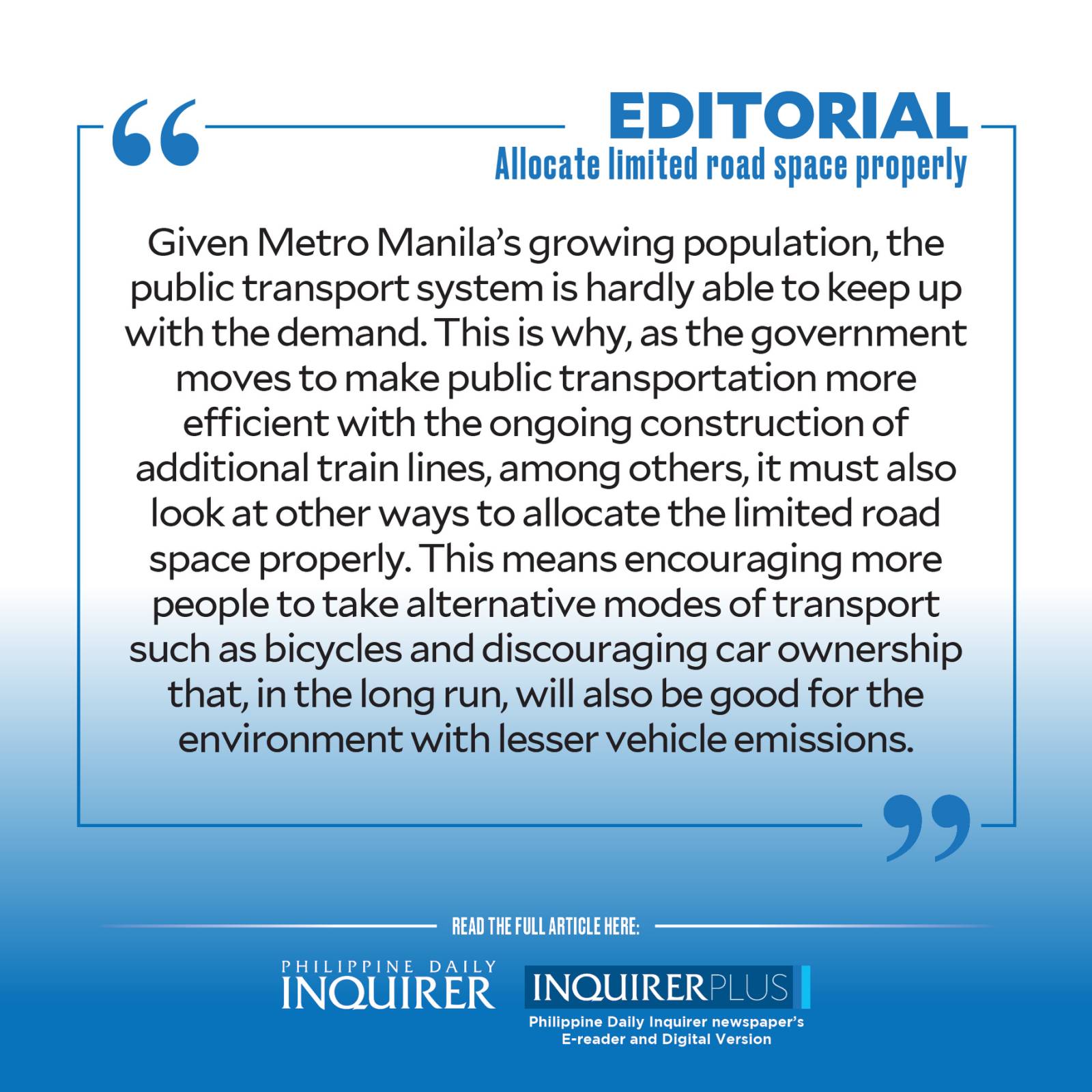Allocate limited road space properly

It hasn’t been a smooth ride to creating a more inclusive road network, especially for bikers who have to fight for every inch of their space.
The latest challenge to achieving this was the proposal to build shared lanes for cyclists and motorists on Edsa that the Metropolitan Manila Development Authority (MMDA) suspended this week after all stakeholders stood their ground that these lanes should remain exclusive for people on bicycles. That there must be an exclusive lane for cyclists should be an easy decision with many accidents proving that mixing people on bikes and motorcycles on these lanes will only lead to accidents.
Much still remains to be done in providing safer and inclusive streets for bikers whose number has seen an increase during the pandemic when the severe lockdowns limited public transportation. The thriving bike culture even led the government to prioritize active transportation with plans of building safer lanes and wider sidewalks in the next few years. The goal, under the Philippine Development Plan (PDP) 2023-2028, is to build a 2,400-kilometer bike lane network nationwide by 2028; as of June, a total of 564 km have already been made in Metro Manila, Metro Cebu, and Metro Davao.
But it has been a constant two steps forward one step back. Cutting the budget for active transport infrastructure—from P2 billion in 2022 and P705 million this year to P500 million in 2024—has made the government’s pronouncements under the PDP that “pedestrians and cyclists will be accorded highest priority in the hierarchy of road users” mere lip service. There is also a lack of policy integration among local governments. Either the bike lanes were carved from existing roads with only light-duty bollards to border them or they were taken down when restrictions were eased and motor vehicle traffic was back. In February, Makati announced that bike lanes along Ayala Avenue would be converted to shared lanes or “sharrows,” but eventually backed down after sustainable mobility advocates protested the move. In April, a group of Metro Manila mayors went to the Netherlands to study that country’s best practices in their bicycle system and urban mobility that can be used locally; four months later, the mayor of San Juan, who was part of that trip, ordered the removal of bollards on bike lanes along Ortigas Avenue because they were allegedly causing traffic congestion and there was a need to “restore the roads to their optimal capacity.” This is the same reasoning for the MMDA wanting to convert the exclusive bicycle lanes along Edsa to shared lanes with motorcycles because they were “underutilized.”
To be sure, it is no easy task to transform the country’s roads, especially in Metro Manila with its messy urban planning, to become bicycle-friendly. It is also an equally challenging task to convince car owners to take public transport to decongest the roads when the system itself is broken and inefficient. The Department of Transportation has committed to improving the country’s transportation system and making it “safe, convenient, accessible, modern, and efficient” but, in its current state, it is a daily scourge for the regular commuter who has to suffer long queues, crowded trains or buses, and traffic jams.
Taking the bike would be the best alternative to avoid these inconveniences—and the increase in bicycle use, with 7.3 million households owning a bicycle as of April 2022, representing a million increase from 6.2 million households in May 2021 according to a Social Weather Stations (SWS) survey last year, shows that more Filipinos are taking to cycling as their mode of transport. Last year, per the MMDA, the number of bicycle trips recorded in key areas in Metro Manila—Ortigas Avenue, Quirino Highway, and Commonwealth Avenue—reached 1,725,908. The same SWS survey noted that 80 percent of Filipinos believe that more people would be encouraged to bike if there were better roads, an expectation that is not quite matched with the actual bad conditions of infrastructure such as potholes, lack of facilities for bikers, as well as dedicated lanes.
Mobility advocates have long been campaigning for the government to find solutions that are focused on moving people rather than cars considering that only about 20 percent of the population are car owners. An average of 136,000 commuters take the train daily but given Metro Manila’s growing population, the public transport system is hardly able to keep up with the demand. This is why, as the government moves to make public transportation more efficient with the ongoing construction of additional train lines, among others, it must also look at other ways to allocate the limited road space properly. This means encouraging more people to take alternative modes of transport such as bicycles and discouraging car ownership that, in the long run, will also be good for the environment with lesser vehicle emissions.
The policies implemented in Metro Manila serve as a model for the rest of the country. MMDA must then ensure that its solutions in decongesting the roads are inclusive—never at the expense of the safety and convenience of the ordinary public commuter who takes the train, bus, or jeep, or rides the bike.




















